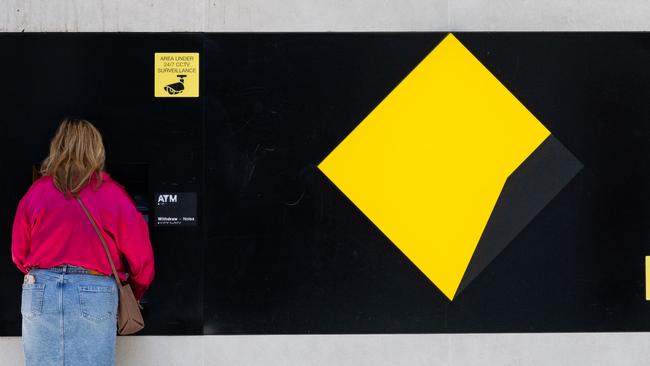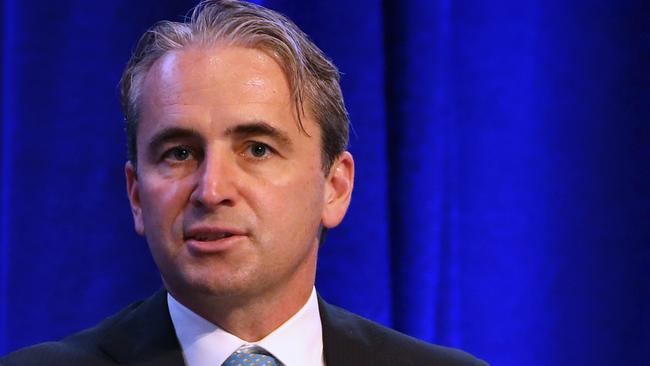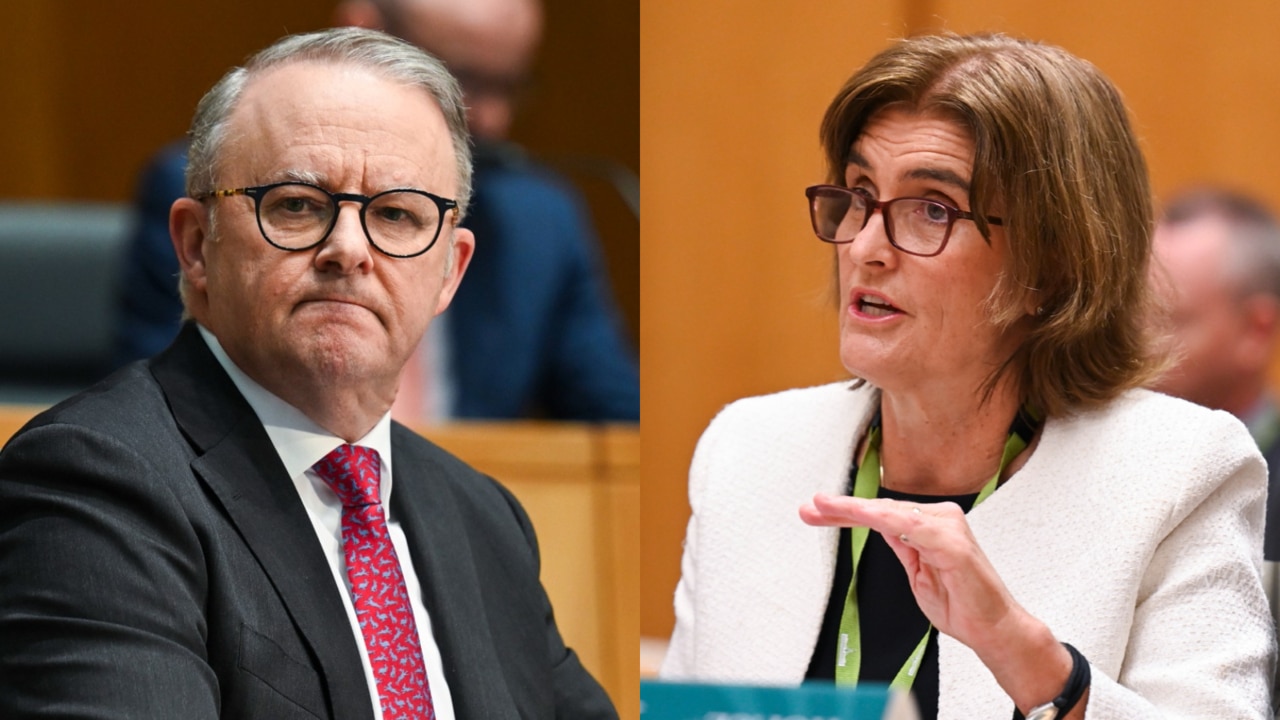CBA posts $9.8bn full year profit as lending squeeze weighs on banking sector
CBA investors will receive a record final dividend but bank boss Matt Comyn has raised the alarm over the housing shortage and says customers are finding it ‘harder and harder’.

Commonwealth Bank chief executive Matt Comyn has expressed alarm at Australia’s housing shortage, warning renters are at the forefront of economic pain, and the country is facing a rise in unemployment that will further stoke economic pressures.
But despite posting a $9.83bn cash profit on Wednesday, CBA told investors it had avoided much of the pain in the economy with its home and business lending operations spitting out cash, and bad loans remaining muted.
Beating analyst expectations, CBA unveiled a record dividend to shareholders, despite a slide from its previous cash profit peak of $10.2bn last year.
CBA told investors it had benefited from a better than expected housing market, with lending margins holding up despite hot competition between banks, and limited exposures to the downturn in the construction sector.
Analysts had tipped a 5 per cent slump in cash earnings to $9.7bn for the bank’s full year results, amid expectations CBA would be squeezed by higher interest rates and home lending doldrums.
But the bank revealed an increase to its mortgage margins in the period, posting a $4.8bn cash result for the second half, just shy of the $5bn first half cash profit.
CBA said its net interest margin on lending had increased 1 basis point in the half, stabilising in the period, after contracting 8 basis points on levels posed last year.
This sees CBA making on average 1.99 per cent profit across the bank’s lending.
Unwinding almost $306m in loan impairment provisions, CBA noted the housing market had performed far better than expected with arrears tracking at a long-term average, despite the recent lifts in interest rates and inflation boom.
But Mr Comyn, who was paid $8.9m in the 2024 financial year, said he remained concerned about Australia’s economy, with downside risks around housing affordability, productivity and global uncertainty.
“We constantly hear from our customers that households and families are finding it harder and harder,” he told The Australian.
Interest rates and housing
Mr Comyn said the spending squeeze, from continued inflation and a surge in housing costs, was impacting everyone, but singled out Australians aged 35-44 with a mortgage as a key area of concern.
The bank revealed the uneven spread of its customer base, with loans clustered among those aged between 25 and 45, far outweighing their savings.
This was offset by those aged 55 and over with far more deposits than mortgages.
Mr Comyn said more housing was needed to help vulnerable Australians, warning he was concerned about the record low vacancy rate, which further fell by 0.01 per cent in July to 1.42 per cent.
“We need to build more housing in a number of areas which are close to transport,” he said.

Mr Comyn noted housing was the area of the most significant increase in cost for customers, up 23 per cent between December 2019 and today.
The bank boss, who took charge of CBA in 2018, said Australia’s economy was proving resilient and supported by low unemployment and continued private and public investment.
“Higher interest rates are slowing the economy and gradually moderating inflation,” he said.
CBA noted it expected unemployment would rise, with the cash rate tipped to fall in the second half of 2024.
But CBA said it expected households would benefit from income tax cuts and electricity rebates, noting they were likely to outweigh the impact of one rate cut.
Home loans
Home loan arrears ticked up across the 12-months to July, with loans 30 days past due tracking at 1.3 per cent.
CBA’s BankWest brand proved the lender’s most trouble division.
However, arrears were lower across loans at 90 days past due, with CBA reporting only 0.65 per cent were in default – sitting at the long-run average.
CBA noted almost 90 per cent of its home lending book had been written under tighter lending standards, which saw the bank apply increased serviceability buffers to borrowers.
The lender said this had led to more borrowers with less additional capacity to borrow.
Impairments
With adjustments and writedowns, CBA reported a $9.48bn statutory profit after churning out $27.1bn in income over the year.
This came after CBA warned investors it would book a combined $387m hit from the divestment of Indonesian Bank subsidiary PT Bank Commonwealth and transition of Bankwest, unveiling a series of hits to its looming full-year results.
Barrenjoey head of banks research Jon Mott, in a results preview, warned CBA was likely to shave its results to avoid a potential political blowback.
“(CBA) is very conscious of balancing stakeholder interests and given the political focus on corporate Australia at present, there is little incentive for CBA to ‘blow the market away’ with a material earnings surprise,” he said.
Despite this Greens leader Adam Bandt took aim at CBA warning “corporations should not be able to make billions in profit when 3.7 million households battle with where their next meal is coming from”.
CBA also told investors it would boost its existing $1bn buyback by a further 12 months after pouring just $282m into the bank’s shares since announcing the program in August last year.

Analysts’ reactions
Shares in CBA are sitting near 12-month highs of about 23.3 times price-to-earnings, after sliding from their peak of 25.6 times on August 1.
The bank’s share price has doubled since early 2020.
Analysts are bearish on CBA, with a Bloomberg consensus 12-month price target of $96.79 per cent, suggesting an almost 26 per cent retreat from current levels.
No analyst has marked up a buy rating against the bank, with only one hold against the stock.
Jarden analyst Jeff Cai said CBA had shown a resilient lending margin and muted bad debts, in a sign for the broader banking sector.
“This should provide scope for positive consensus earnings revisions in FY25E, although we find CBA’s valuation stretched,” he said.
But Citi analyst Brendan Sproules said there were “obvious question marks” around the impact on rates on CBA’s asset quality
“Asset quality and rates remain large uncertainties that neither us nor management can be definitive on, but ones with large downside risk, in our view,” he said.
Atlas Funds Management chief investment officer Hugh Dive said CBA had kept its results “on a tightrope”.
“It was priced for absolute perfection, there was not a lot of room for error,” he said.
The bank declared a $2.50 final dividend, up on the $2.15 declared for the first half, taking total returns for the year to $4.65.
This was up on the $4.50 handed to shareholders last year.
CBA shares closed up $1.41 or 1.06 per cent to $133.93.






To join the conversation, please log in. Don't have an account? Register
Join the conversation, you are commenting as Logout